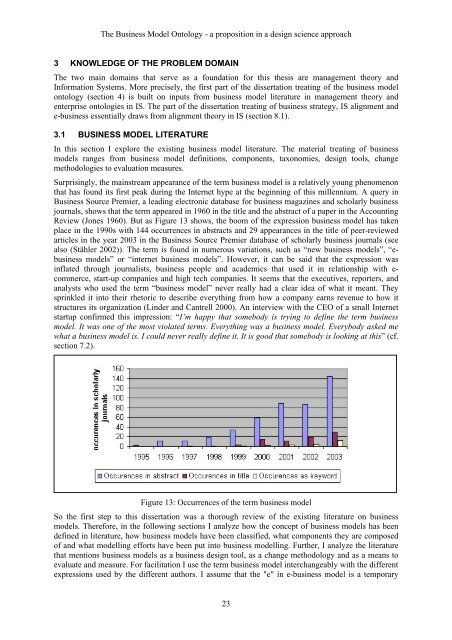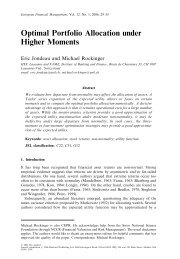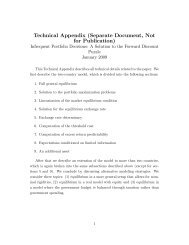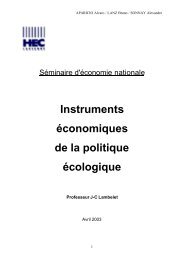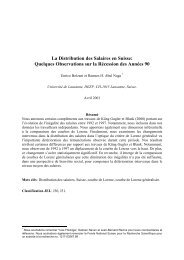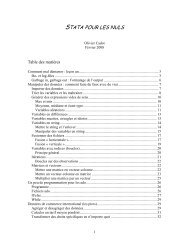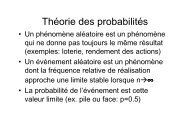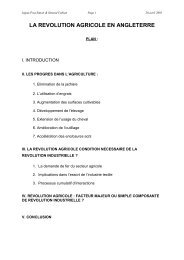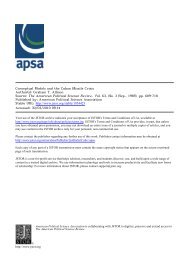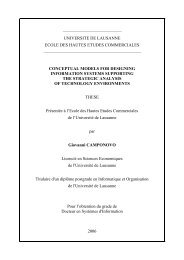The Business Model Ontology - a proposition in a design ... - HEC
The Business Model Ontology - a proposition in a design ... - HEC
The Business Model Ontology - a proposition in a design ... - HEC
You also want an ePaper? Increase the reach of your titles
YUMPU automatically turns print PDFs into web optimized ePapers that Google loves.
<strong>The</strong> <strong>Bus<strong>in</strong>ess</strong> <strong>Model</strong> <strong>Ontology</strong> - a <strong>proposition</strong> <strong>in</strong> a <strong>design</strong> science approach<br />
3 KNOWLEDGE OF THE PROBLEM DOMAIN<br />
<strong>The</strong> two ma<strong>in</strong> doma<strong>in</strong>s that serve as a foundation for this thesis are management theory and<br />
Information Systems. More precisely, the first part of the dissertation treat<strong>in</strong>g of the bus<strong>in</strong>ess model<br />
ontology (section 4) is built on <strong>in</strong>puts from bus<strong>in</strong>ess model literature <strong>in</strong> management theory and<br />
enterprise ontologies <strong>in</strong> IS. <strong>The</strong> part of the dissertation treat<strong>in</strong>g of bus<strong>in</strong>ess strategy, IS alignment and<br />
e-bus<strong>in</strong>ess essentially draws from alignment theory <strong>in</strong> IS (section 8.1).<br />
3.1 BUSINESS MODEL LITERATURE<br />
In this section I explore the exist<strong>in</strong>g bus<strong>in</strong>ess model literature. <strong>The</strong> material treat<strong>in</strong>g of bus<strong>in</strong>ess<br />
models ranges from bus<strong>in</strong>ess model def<strong>in</strong>itions, components, taxonomies, <strong>design</strong> tools, change<br />
methodologies to evaluation measures.<br />
Surpris<strong>in</strong>gly, the ma<strong>in</strong>stream appearance of the term bus<strong>in</strong>ess model is a relatively young phenomenon<br />
that has found its first peak dur<strong>in</strong>g the Internet hype at the beg<strong>in</strong>n<strong>in</strong>g of this millennium. A query <strong>in</strong><br />
<strong>Bus<strong>in</strong>ess</strong> Source Premier, a lead<strong>in</strong>g electronic database for bus<strong>in</strong>ess magaz<strong>in</strong>es and scholarly bus<strong>in</strong>ess<br />
journals, shows that the term appeared <strong>in</strong> 1960 <strong>in</strong> the title and the abstract of a paper <strong>in</strong> the Account<strong>in</strong>g<br />
Review (Jones 1960). But as Figure 13 shows, the boom of the expression bus<strong>in</strong>ess model has taken<br />
place <strong>in</strong> the 1990s with 144 occurrences <strong>in</strong> abstracts and 29 appearances <strong>in</strong> the title of peer-reviewed<br />
articles <strong>in</strong> the year 2003 <strong>in</strong> the <strong>Bus<strong>in</strong>ess</strong> Source Premier database of scholarly bus<strong>in</strong>ess journals (see<br />
also (Stähler 2002)). <strong>The</strong> term is found <strong>in</strong> numerous variations, such as “new bus<strong>in</strong>ess models”, “ebus<strong>in</strong>ess<br />
models” or “<strong>in</strong>ternet bus<strong>in</strong>ess models”. However, it can be said that the expression was<br />
<strong>in</strong>flated through journalists, bus<strong>in</strong>ess people and academics that used it <strong>in</strong> relationship with e-<br />
commerce, start-up companies and high tech companies. It seems that the executives, reporters, and<br />
analysts who used the term “bus<strong>in</strong>ess model” never really had a clear idea of what it meant. <strong>The</strong>y<br />
spr<strong>in</strong>kled it <strong>in</strong>to their rhetoric to describe everyth<strong>in</strong>g from how a company earns revenue to how it<br />
structures its organization (L<strong>in</strong>der and Cantrell 2000). An <strong>in</strong>terview with the CEO of a small Internet<br />
startup confirmed this impression: “I’m happy that somebody is try<strong>in</strong>g to def<strong>in</strong>e the term bus<strong>in</strong>ess<br />
model. It was one of the most violated terms. Everyth<strong>in</strong>g was a bus<strong>in</strong>ess model. Everybody asked me<br />
what a bus<strong>in</strong>ess model is. I could never really def<strong>in</strong>e it. It is good that somebody is look<strong>in</strong>g at this” (cf.<br />
section 7.2).<br />
Figure 13: Occurrences of the term bus<strong>in</strong>ess model<br />
So the first step to this dissertation was a thorough review of the exist<strong>in</strong>g literature on bus<strong>in</strong>ess<br />
models. <strong>The</strong>refore, <strong>in</strong> the follow<strong>in</strong>g sections I analyze how the concept of bus<strong>in</strong>ess models has been<br />
def<strong>in</strong>ed <strong>in</strong> literature, how bus<strong>in</strong>ess models have been classified, what components they are composed<br />
of and what modell<strong>in</strong>g efforts have been put <strong>in</strong>to bus<strong>in</strong>ess modell<strong>in</strong>g. Further, I analyze the literature<br />
that mentions bus<strong>in</strong>ess models as a bus<strong>in</strong>ess <strong>design</strong> tool, as a change methodology and as a means to<br />
evaluate and measure. For facilitation I use the term bus<strong>in</strong>ess model <strong>in</strong>terchangeably with the different<br />
expressions used by the different authors. I assume that the "e" <strong>in</strong> e-bus<strong>in</strong>ess model is a temporary<br />
23
Knowledge of the Problem Doma<strong>in</strong><br />
phenomenon that will disappear <strong>in</strong> time because most bus<strong>in</strong>ess models will have some ICT<br />
component.<br />
Authors<br />
Def<strong>in</strong>ition<br />
Taxonomy<br />
Components<br />
Representation<br />
Tool<br />
Ontological<br />
<strong>Model</strong><strong>in</strong>g<br />
Change<br />
Methodology<br />
Evaluation<br />
Measures<br />
(Afuah and Tucci 2001; 2003) X X X<br />
(Alt and Zimmermann 2001) X X<br />
(Amit and Zott 2001)<br />
(Applegate 2001) X X<br />
(Bagchi and Tulskie 2000)<br />
(Chesbrough and Rosenbloom 2000)<br />
(Gordijn 2002) X X X X<br />
(Hamel 2000) X X<br />
(Hawk<strong>in</strong>s 2001)<br />
(L<strong>in</strong>der and Cantrell 2000) X X X X<br />
(Magretta 2002) X X<br />
(Mahadevan 2000)<br />
(Maitland and Van de Kar 2002)<br />
(Papakiriakopoulos and Poulymenakou 2001)<br />
(Peterovic, Kittl et al. 2001) X X X<br />
(Rappa 2001) X X<br />
(Stähler 2002)<br />
(Tapscott, Ticoll et al. 2000) X X X X<br />
(Timmers 1998) X X<br />
(Weill and Vitale 2001) X X X X<br />
X<br />
X<br />
Table 2: <strong>Bus<strong>in</strong>ess</strong> model authors list (partially based on (Pateli 2002))<br />
Table 2 summarizes the contributions of the most important bus<strong>in</strong>ess model authors. <strong>The</strong> first two<br />
columns of the table name author and year of contribution and the follow<strong>in</strong>g columns reveal the major<br />
bus<strong>in</strong>ess model areas covered and whether a specific author has contributed to this area. <strong>The</strong> first<br />
"def<strong>in</strong>ition" column shows if an author provides a short comprehensible def<strong>in</strong>ition of what a bus<strong>in</strong>ess<br />
model is. <strong>The</strong> "taxonomy" column <strong>in</strong>dicates which authors propose a classification of bus<strong>in</strong>ess models.<br />
<strong>The</strong> "components" column po<strong>in</strong>ts out authors that go beyond a simple def<strong>in</strong>ition and classification of<br />
bus<strong>in</strong>ess models by present<strong>in</strong>g a conceptual approach to bus<strong>in</strong>ess models, propos<strong>in</strong>g a set of bus<strong>in</strong>ess<br />
model components. Simply put, they specify of what a bus<strong>in</strong>ess model is composed of. <strong>The</strong><br />
"representation tool" column specifies authors that offer a set of tools or graphical representations to<br />
<strong>design</strong> bus<strong>in</strong>ess models. <strong>The</strong> "ontological modell<strong>in</strong>g" column <strong>in</strong>dicates authors that use a rigorous<br />
modell<strong>in</strong>g approach to bus<strong>in</strong>ess models. Authors present <strong>in</strong> this category provide an ontology that<br />
carefully def<strong>in</strong>es bus<strong>in</strong>ess model concepts, components and relationships among components. <strong>The</strong><br />
"change methodology" column po<strong>in</strong>ts to authors <strong>in</strong>clud<strong>in</strong>g a time and change component <strong>in</strong> their<br />
bus<strong>in</strong>ess model concepts. F<strong>in</strong>ally, the "evaluation measures" column <strong>in</strong>dicates authors that try to<br />
def<strong>in</strong>e <strong>in</strong>dicators to measure the success of bus<strong>in</strong>ess models.<br />
24<br />
X<br />
X<br />
X<br />
X<br />
X
<strong>The</strong> <strong>Bus<strong>in</strong>ess</strong> <strong>Model</strong> <strong>Ontology</strong> - a <strong>proposition</strong> <strong>in</strong> a <strong>design</strong> science approach<br />
3.1.1 <strong>Bus<strong>in</strong>ess</strong> <strong>Model</strong> Def<strong>in</strong>itions<br />
<strong>The</strong> first column of Table 2 covers bus<strong>in</strong>ess model def<strong>in</strong>itions. Paul Timmers, then work<strong>in</strong>g for the<br />
European Commission, was one of the first to explicitly def<strong>in</strong>e and classify bus<strong>in</strong>ess models (Timmers<br />
1998). He understands a bus<strong>in</strong>ess model as the architecture for the product, service and <strong>in</strong>formation<br />
flows, <strong>in</strong>clud<strong>in</strong>g a description of the various bus<strong>in</strong>ess actors and their roles and a description of the<br />
potential benefits for the various bus<strong>in</strong>ess actors and a description of the sources of revenues. In order<br />
to understand how a company realizes its bus<strong>in</strong>ess mission he adds a market<strong>in</strong>g model that is the<br />
comb<strong>in</strong>ation of the bus<strong>in</strong>ess model and the market<strong>in</strong>g strategy of the bus<strong>in</strong>ess actor under<br />
consideration. Like Timmers, Weill and Vitale (Weill and Vitale 2001) def<strong>in</strong>e a bus<strong>in</strong>ess model as a<br />
description of the roles and relationships among a firm’s consumers, customers, allies and suppliers<br />
and it identifies the major flows of product, <strong>in</strong>formation, and money, as well as the major benefits to<br />
participants.<br />
In their bus<strong>in</strong>ess model def<strong>in</strong>ition L<strong>in</strong>der and Cantrell (2000) from the Accenture Institute for Strategic<br />
Change differentiate between three different types of models: the components of a bus<strong>in</strong>ess model,<br />
real operat<strong>in</strong>g bus<strong>in</strong>ess models and change models. <strong>The</strong>y def<strong>in</strong>e a bus<strong>in</strong>ess model as an organization’s<br />
core logic for creat<strong>in</strong>g value. Similarly, Petrovic, Kittl et al. (2001) perceive bus<strong>in</strong>ess models as the<br />
logic of a bus<strong>in</strong>ess system for creat<strong>in</strong>g value. <strong>The</strong>y specify that this is <strong>in</strong> opposition to a description of<br />
a complex social system itself with all its actors, relations and processes. Referr<strong>in</strong>g to this Gordijn,<br />
Akkermans et al. (2000) mention that <strong>in</strong> research as well as <strong>in</strong> <strong>in</strong>dustry practice, often bus<strong>in</strong>ess models<br />
are wrongly understood as bus<strong>in</strong>ess process models, and so can be specified us<strong>in</strong>g UML activity<br />
diagrams or Petri nets. <strong>The</strong>y expla<strong>in</strong> that this is a misunderstand<strong>in</strong>g and that a bus<strong>in</strong>ess model is not<br />
about processes but about value exchanged between actors. In their op<strong>in</strong>ion the failure to make this<br />
separation leads to poor bus<strong>in</strong>ess decision-mak<strong>in</strong>g and <strong>in</strong>adequate bus<strong>in</strong>ess requirements.<br />
Like Petrovic, Kittl et al. (2001) Applegate (2001) perceives a bus<strong>in</strong>ess model as a description of a<br />
complex bus<strong>in</strong>ess that enables the study of its structure, of the relationships among structural elements,<br />
and of how it will respond to the real world. In this regard Stähler (2002) rem<strong>in</strong>ds that a model is<br />
always a simplification of the complex reality. It helps to understand the fundamentals of a bus<strong>in</strong>ess or<br />
to plan how a future bus<strong>in</strong>ess should look like. Magretta (2002) adds that a bus<strong>in</strong>ess model is like a<br />
story that expla<strong>in</strong>s how an enterprise works. And like Stähler she dist<strong>in</strong>guishes the concept of bus<strong>in</strong>ess<br />
models from the concept of strategy. She expla<strong>in</strong>s that bus<strong>in</strong>ess models describe, as a system, how the<br />
pieces of a bus<strong>in</strong>ess fit together, but as opposed to strategy do not <strong>in</strong>clude performance and<br />
competition.<br />
Tapscott, Ticoll et al. (2000) do not directly def<strong>in</strong>e bus<strong>in</strong>ess models, but what they call b-webs<br />
(bus<strong>in</strong>ess webs). A b-web is a bus<strong>in</strong>ess on the <strong>in</strong>ternet and represents a dist<strong>in</strong>ct system of suppliers,<br />
distributors, commerce service providers, <strong>in</strong>frastructure providers, and customers that use the Internet<br />
for their primary bus<strong>in</strong>ess communication and transactions. Similarly, another highly networkcentered<br />
approach is provided by Amit and Zott (2001). <strong>The</strong>y describe a bus<strong>in</strong>ess model as the<br />
architectural configuration of the components of transactions <strong>design</strong>ed to exploit bus<strong>in</strong>ess<br />
opportunities. <strong>The</strong>ir framework depicts the ways <strong>in</strong> which transactions are enabled by a network of<br />
firms, suppliers, complementors and customers.<br />
A series of authors <strong>in</strong>troduce a f<strong>in</strong>ancial element <strong>in</strong>to their def<strong>in</strong>itions. Afuah and Tucci (2003) state<br />
that each firm that exploits the Internet should have an Internet bus<strong>in</strong>ess model. <strong>The</strong>y understand it as<br />
a set of Internet- and non-Internet-related activities that allow a firm to make money <strong>in</strong> a susta<strong>in</strong>able<br />
way. Hawk<strong>in</strong>s (2001) describes a bus<strong>in</strong>ess model as the commercial relationship between a bus<strong>in</strong>ess<br />
enterprise and the products and/or services it provides <strong>in</strong> the market. He expla<strong>in</strong>s that it is a way of<br />
structur<strong>in</strong>g various cost and revenue streams such that a bus<strong>in</strong>ess becomes viable, usually <strong>in</strong> the sense<br />
of be<strong>in</strong>g able to susta<strong>in</strong> itself on the basis of <strong>in</strong>come it generates. Rappa (2001) def<strong>in</strong>es a bus<strong>in</strong>ess<br />
model as the method of do<strong>in</strong>g bus<strong>in</strong>ess by which a company can susta<strong>in</strong> itself -- that is, generate<br />
revenue. For him the bus<strong>in</strong>ess model spells-out how a company makes money by specify<strong>in</strong>g where it<br />
is positioned <strong>in</strong> the value cha<strong>in</strong>.<br />
25
Knowledge of the Problem Doma<strong>in</strong><br />
3.1.2 <strong>Bus<strong>in</strong>ess</strong> <strong>Model</strong> Taxonomies<br />
Apart from def<strong>in</strong>itions a number of authors provide us with bus<strong>in</strong>ess model taxonomies. This means<br />
that they classify bus<strong>in</strong>ess models with a certa<strong>in</strong> number of common characteristics <strong>in</strong> a set of different<br />
categories. <strong>The</strong> probably best known classification scheme and def<strong>in</strong>ition of electronic bus<strong>in</strong>ess<br />
models is the one of Timmers (1998). He dist<strong>in</strong>guishes between eleven generic e-bus<strong>in</strong>ess models and<br />
classifies them accord<strong>in</strong>g to their degree of <strong>in</strong>novation and their functional <strong>in</strong>tegration (see Figure 14).<br />
<strong>The</strong> models are e-shops, e-procurement, e-malls, e-auctions, virtual communities, collaboration<br />
platforms, third-party marketplaces, value cha<strong>in</strong> <strong>in</strong>tegrators, value-cha<strong>in</strong> service providers, <strong>in</strong>formation<br />
brokerage and trust and other third-party services (see Table 3).<br />
Multiple<br />
Functions/<br />
Integrated<br />
Value Cha<strong>in</strong> Integrator<br />
Third Party Marketplace<br />
Degree of<br />
Integration<br />
E-Procurement<br />
E-Mall<br />
Collaboration Platform<br />
Virtual Community<br />
Value Cha<strong>in</strong> Service Provider<br />
E-Auction<br />
E-Shop<br />
Trust Services<br />
S<strong>in</strong>gle<br />
Function<br />
lower<br />
Degree of Innovation<br />
Info Brokerage<br />
higher<br />
Figure 14: Figure: Timmer’s (1998) classification scheme<br />
Category<br />
e-Shops<br />
e-Procurement<br />
e-Malls<br />
e-Auctions<br />
Virtual communities<br />
Collaboration<br />
platforms<br />
Third-party<br />
marketplaces<br />
Value cha<strong>in</strong><br />
<strong>in</strong>tegrators<br />
Value-cha<strong>in</strong> service<br />
providers<br />
Information<br />
brokerage<br />
Trust and other<br />
Description<br />
Stands for the Web market<strong>in</strong>g and promotion of a company or a shop and<br />
<strong>in</strong>creas<strong>in</strong>gly <strong>in</strong>cludes the possibility to order and to pay.<br />
Describes electronic tender<strong>in</strong>g and procurement of goods and services.<br />
Stands for the electronic implementation of the bidd<strong>in</strong>g mechanism also known<br />
from traditional auctions.<br />
Consists of a collection of e-shops, usually enhanced by a common umbrella, for<br />
example a well-known brand.<br />
This model br<strong>in</strong>gs together virtual communities that contribute value <strong>in</strong> a basic<br />
environment provided by the virtual community operator. Membership fees and<br />
advertis<strong>in</strong>g generate revenues. It can also be found as an add-on to other<br />
market<strong>in</strong>g operations for customer feedback or loyalty build<strong>in</strong>g.<br />
Companies of this group provide a set of tools and <strong>in</strong>formation environment for<br />
collaboration between enterprises.<br />
A model that is suitable when a company wishes to leave the Web market<strong>in</strong>g to<br />
a 3 rd party (possibly as an add-on to their other channels). Third-party<br />
marketplaces offer a user <strong>in</strong>terface to the supplier's product catalogue.<br />
Represents the companies that focus on <strong>in</strong>tegrat<strong>in</strong>g multiple steps of the value<br />
cha<strong>in</strong>, with the potential to exploit the <strong>in</strong>formation flow between those steps as<br />
further added value.<br />
Stands for companies that specialize on a specific function for the value cha<strong>in</strong>,<br />
such as electronic payment or logistics.<br />
Embraces a whole range of new <strong>in</strong>formation services that are emerg<strong>in</strong>g to add<br />
value to the huge amounts of data available on the open networks or com<strong>in</strong>g<br />
from <strong>in</strong>tegrated bus<strong>in</strong>ess operations.<br />
Stands for trust services, such as certification authorities and electronic notaries<br />
26
<strong>The</strong> <strong>Bus<strong>in</strong>ess</strong> <strong>Model</strong> <strong>Ontology</strong> - a <strong>proposition</strong> <strong>in</strong> a <strong>design</strong> science approach<br />
third-party services<br />
and other trusted third parties.<br />
Table 3: Timmer’s architectures of bus<strong>in</strong>ess models (Timmers 1998)<br />
Alt and Zimmermann (2001) po<strong>in</strong>t out that there are two major categories of bus<strong>in</strong>ess models, one<br />
based on the object of the bus<strong>in</strong>ess model and the other based on the purpose of the bus<strong>in</strong>ess model.<br />
<strong>The</strong> first group <strong>in</strong>cludes market and role models, sector and <strong>in</strong>dustry models and f<strong>in</strong>ally revenue<br />
models. <strong>The</strong> second group <strong>in</strong>cludes bus<strong>in</strong>ess models, reference models and simulation models.<br />
Tapscott et al. (2000) proposes a network- and value-centered taxonomy that dist<strong>in</strong>guishes between<br />
five types of value networks, which differ <strong>in</strong> their degree of economic control and value <strong>in</strong>tegration<br />
(see Figure 15 and Table 4). <strong>The</strong>y call these types b-webs (bus<strong>in</strong>ess webs). <strong>The</strong> first one, the so-called<br />
Agora facilitates exchange between buyers and sellers, who jo<strong>in</strong>tly discover a price through on-thespot<br />
negotiations (e.g. eBay). In the second type, the Aggregation b-web, one company leads <strong>in</strong><br />
hierarchical fashion, position<strong>in</strong>g itself as a value-add<strong>in</strong>g <strong>in</strong>termediary between producers and<br />
customers (e.g. Amazon.com). In the third b-web, the Value Cha<strong>in</strong>, a context provider structures and<br />
directs the network to produce highly <strong>in</strong>tegrated value <strong>proposition</strong>s (e.g. Dell). <strong>The</strong> fourth network, the<br />
Alliance, strives for high value <strong>in</strong>tegration without hierarchical control (e.g. L<strong>in</strong>ux). <strong>The</strong> last type,<br />
Distributive Networks, keeps the economy alive and mobile (e.g. FedEx).<br />
Self-organiz<strong>in</strong>g<br />
CONTROL<br />
Agora<br />
Aggregation<br />
Distributive<br />
Network<br />
Alliance<br />
Value Cha<strong>in</strong><br />
Hierarchical<br />
Low<br />
VALUE INTEGRATION<br />
High<br />
Type of b-web<br />
Agora<br />
Aggregation<br />
Value Cha<strong>in</strong><br />
Alliance<br />
Distributive Network<br />
Figure 15: b-webs (Tapscott, Ticoll et al. 2000)<br />
Description<br />
Applies to markets where buyers and sellers meet to freely negotiate and<br />
assign value to goods. An Agora facilitates exchange between buyers and<br />
sellers, who jo<strong>in</strong>tly "discover" a price. Because sellers may offer a wide and<br />
often unpredictable variety or quantity of goods, value <strong>in</strong>tegration is low.<br />
In Aggregation b-webs there is a leader that takes responsibility for select<strong>in</strong>g<br />
products and services, target<strong>in</strong>g market segments, sett<strong>in</strong>g prices, and ensur<strong>in</strong>g<br />
fulfillment. This leader typically sets prices <strong>in</strong> advance and offers a diverse<br />
variety of products and services, with zero to limited value <strong>in</strong>tegration.<br />
In a Value Cha<strong>in</strong>, the so-called context provider structures and directs a b-web<br />
network to produce a highly <strong>in</strong>tegrated value <strong>proposition</strong>. <strong>The</strong> seller has the<br />
f<strong>in</strong>al say <strong>in</strong> pric<strong>in</strong>g.<br />
An Alliance strives for high value <strong>in</strong>tegration without hierarchical control. Its<br />
participants <strong>design</strong> goods or services, create knowledge, or simply produces<br />
dynamic, shared experiences. Alliances typically depend on rules and<br />
standards that govern <strong>in</strong>teraction, acceptable participant behavior, and the<br />
determ<strong>in</strong>ation of value.<br />
Distributive Networks are b-webs that keep the economy alive and mobile.<br />
<strong>The</strong>y play a vital role <strong>in</strong> ensur<strong>in</strong>g the healthy balance of the systems that they<br />
support. Distributive Networks service the other types of b-webs by allocat<strong>in</strong>g<br />
and deliver<strong>in</strong>g goods.<br />
Table 4: Taxonomy of b-webs (Tapscott, Ticoll et al. 2000)<br />
27
Knowledge of the Problem Doma<strong>in</strong><br />
L<strong>in</strong>der and Cantrell (2000) propose categoriz<strong>in</strong>g bus<strong>in</strong>ess models focus<strong>in</strong>g on two ma<strong>in</strong> dimensions,<br />
which are a model’s core, profit-mak<strong>in</strong>g activity, and its relative position on the price/value cont<strong>in</strong>uum<br />
(see Table 5).<br />
<strong>Bus<strong>in</strong>ess</strong> <strong>Model</strong> Category<br />
Price <strong>Model</strong>s<br />
Convenience <strong>Model</strong>s<br />
Commodity-Plus <strong>Model</strong>s<br />
Experience <strong>Model</strong>s<br />
Channel <strong>Model</strong>s<br />
Intermediary <strong>Model</strong>s<br />
Trust <strong>Model</strong>s<br />
Innovation <strong>Model</strong>s<br />
<strong>Bus<strong>in</strong>ess</strong> <strong>Model</strong>s<br />
Buy<strong>in</strong>g Club, One-stop, low-price shopp<strong>in</strong>g<br />
Fee for advertis<strong>in</strong>g, Razor and blade<br />
One-stop, convenient shopp<strong>in</strong>g,<br />
Comprehensive offer<strong>in</strong>g, Instant gratification<br />
Low-price reliable commodity, Mass customised<br />
commodity, Service-wrapped commodity<br />
Experience sell<strong>in</strong>g, Cool brands<br />
Channel maximisation, Quality sell<strong>in</strong>g, Value-added reseller<br />
Market aggregation, Open market-mak<strong>in</strong>g, Multi-party<br />
market aggregation<br />
Trusted operations, Trusted product leadership, Trusted<br />
service leadership<br />
Incomparable products, Incomparable services,<br />
Breakthrough markets<br />
Table 5: L<strong>in</strong>der and Cantrell’s (2000) categorization of bus<strong>in</strong>ess models<br />
Weill and Vitale (2001) describe eight so-called atomic bus<strong>in</strong>ess models. Each model describes a<br />
different way of conduct<strong>in</strong>g bus<strong>in</strong>ess electronically. <strong>The</strong>y describe these atomic e-bus<strong>in</strong>ess models as<br />
the basic build<strong>in</strong>g blocks of an e-bus<strong>in</strong>ess <strong>in</strong>itiative (see Table 6).<br />
Atomic <strong>Bus<strong>in</strong>ess</strong> <strong>Model</strong><br />
Content Provider<br />
Direct to Customer<br />
Full-Service Provider<br />
Intermediary<br />
Shared Infrastructure<br />
Value net Integrator<br />
Virtual Community<br />
Whole-of-<br />
Enterprise/Government<br />
Description<br />
Content providers are firms that create and provide content (<strong>in</strong>formation,<br />
products, or services) <strong>in</strong> digital form to customers via third parties.<br />
In this model, the buyer and seller <strong>in</strong>teract directly often bypass<strong>in</strong>g traditional<br />
channel members.<br />
Firms <strong>in</strong> this category provide total coverage of customer needs <strong>in</strong> a particular<br />
doma<strong>in</strong>, consolidated via a s<strong>in</strong>gle po<strong>in</strong>t of contact. Doma<strong>in</strong>s cover any area<br />
where customer needs cover multiple products and services, such as f<strong>in</strong>ancial<br />
services or health care.<br />
<strong>The</strong> <strong>in</strong>termediary l<strong>in</strong>ks multiple buyers and sellers. Usually the sellers pay the<br />
<strong>in</strong>termediary list<strong>in</strong>g fees and sell<strong>in</strong>g commissions and it is possible that the<br />
buyer may also pay a purchase or membership fee. Advertisers also provide<br />
revenue for <strong>in</strong>termediaries. <strong>The</strong>re are six major classes of <strong>in</strong>termediaries,<br />
namely electronic mall, shopp<strong>in</strong>g agents, specialty auctions, portals, electronic<br />
auctions and electronic markets.<br />
In this atomic bus<strong>in</strong>ess model a firm provides <strong>in</strong>frastructure shared by its<br />
owners. <strong>The</strong> shared <strong>in</strong>frastructure generally offers a service that is not already<br />
available <strong>in</strong> the marketplace, and it may also be a defensive move to thwart<br />
potential dom<strong>in</strong>ation by another major player.<br />
<strong>The</strong> value net <strong>in</strong>tegrator coord<strong>in</strong>ates product flows from suppliers to allies and<br />
customers. He strives to own the customer relationship with the other<br />
participants <strong>in</strong> the model, thus know<strong>in</strong>g more about their operations than any<br />
other player. His ma<strong>in</strong> role is coord<strong>in</strong>at<strong>in</strong>g the value cha<strong>in</strong>.<br />
In this model the firm is <strong>in</strong> the center, positioned between members of the<br />
community and suppliers. Fundamental to the success of this model is that<br />
members are able to communicate with each other directly.<br />
<strong>The</strong> s<strong>in</strong>gle po<strong>in</strong>t of contact for the e-bus<strong>in</strong>ess customer is the essence of the<br />
whole-of-enterprise atomic bus<strong>in</strong>ess model. This model plays an important<br />
28
<strong>The</strong> <strong>Bus<strong>in</strong>ess</strong> <strong>Model</strong> <strong>Ontology</strong> - a <strong>proposition</strong> <strong>in</strong> a <strong>design</strong> science approach<br />
role <strong>in</strong> public-sector organizations but also applies to the private sector.<br />
Table 6: Weill and Vitale’s (2001) atomic bus<strong>in</strong>ess models<br />
For Rappa (2001) a bus<strong>in</strong>ess model spells-out how a company makes money by specify<strong>in</strong>g where it is<br />
positioned <strong>in</strong> the value cha<strong>in</strong>. His classification scheme consists of n<strong>in</strong>e generic forms of e-bus<strong>in</strong>ess<br />
models, which are Brokerage, Advertis<strong>in</strong>g, Infomediary, Merchant, Manufacturer, Affiliate,<br />
Community, Subscription and Utility (see Table 7). <strong>The</strong>se generic models essentially classify<br />
companies among the nature of their value <strong>proposition</strong> or their mode of generat<strong>in</strong>g revenues (e.g.<br />
advertis<strong>in</strong>g, subscription or utility model).<br />
Type of <strong>Model</strong> Subcategories Description<br />
Brokerage<br />
<strong>Model</strong><br />
Advertis<strong>in</strong>g<br />
<strong>Model</strong><br />
Infomediary<br />
<strong>Model</strong><br />
Merchant<br />
<strong>Model</strong><br />
Manufacturer<br />
<strong>Model</strong><br />
Affiliate <strong>Model</strong><br />
Community<br />
<strong>Model</strong><br />
Subscription<br />
<strong>Model</strong><br />
Utility <strong>Model</strong><br />
Marketplace Exchange, <strong>Bus<strong>in</strong>ess</strong><br />
Trad<strong>in</strong>g Community, Buy/ Sell<br />
Fulfilment, Demand Collection<br />
System, Auction Broker, Transaction<br />
Broker, Bounty Broker, Distributor,<br />
Search Agent, Virtual Mall<br />
Portal, Personalised Portal, Niche<br />
Portal, Classifieds, Registered Users,<br />
Query-based Paid Placement,<br />
Contextual Advertis<strong>in</strong>g<br />
Advertis<strong>in</strong>g Networks, Audience<br />
Measurement Services, Incentive<br />
Market<strong>in</strong>g, Metamediary<br />
Virtual Merchant, Catalog Merchant,<br />
Click and Mortar, Bit Vendor<br />
Brand Integrated Content<br />
Voluntary Contributor <strong>Model</strong>,<br />
Knowledge Networks<br />
Content Services, Person-to-Person<br />
Network<strong>in</strong>g Services, Trust Services,<br />
Internet Service Providers<br />
<strong>The</strong>y br<strong>in</strong>g buyers and sellers together and<br />
facilitate transactions. Usually, a broker<br />
charges a fee or commission for each<br />
transaction it enables.<br />
<strong>The</strong> broadcaster, <strong>in</strong> this case a web site,<br />
provides content (usually for free) and services<br />
(like email, chat, forums) mixed with<br />
advertis<strong>in</strong>g messages <strong>in</strong> the form of banner<br />
ads. <strong>The</strong> banner ads may be the major or sole<br />
source of revenue for the broadcaster. <strong>The</strong><br />
broadcaster may be a content creator or a<br />
distributor of content created elsewhere.<br />
Some firms function as <strong>in</strong>fomediaries<br />
(<strong>in</strong>formation <strong>in</strong>termediaries) by either<br />
collect<strong>in</strong>g data about consumers or collect<strong>in</strong>g<br />
data about producers and their products.<br />
Wholesalers and retailers of goods and<br />
services.<br />
Manufacturers can reach buyers directly and<br />
thereby compress the distribution channel.<br />
<strong>The</strong> affiliate model provides purchase<br />
opportunities wherever people may be surf<strong>in</strong>g.<br />
It does this by offer<strong>in</strong>g f<strong>in</strong>ancial <strong>in</strong>centives (<strong>in</strong><br />
the form of a percentage of revenue) to<br />
affiliated partner sites. <strong>The</strong> affiliates provide<br />
purchase-po<strong>in</strong>t click-through to the merchant<br />
via their web sites.<br />
<strong>The</strong> community model is based on user<br />
loyalty. Users have a high <strong>in</strong>vestment <strong>in</strong> time<br />
and emotion <strong>in</strong> the site. In some cases, users<br />
are regular contributors of content and/or<br />
money.<br />
Users are charged a periodic – daily, monthly<br />
or annual – fee to subscribe to a service.<br />
<strong>The</strong> utility model is based on meter<strong>in</strong>g usage,<br />
or a pay as you go approach. Unlike subscriber<br />
services, metered services are based on actual<br />
usage rates<br />
Table 7: Rappa’s (Rappa 2001) classification scheme<br />
Applegate (Applegate 2001) identifies four categories for digital bus<strong>in</strong>ess models, for which she gives<br />
a number of examples (see Table 8).<br />
29
Knowledge of the Problem Doma<strong>in</strong><br />
<strong>Bus<strong>in</strong>ess</strong> <strong>Model</strong> Category<br />
Focused Distributor <strong>Model</strong>s<br />
Portal <strong>Model</strong>s<br />
Producer <strong>Model</strong>s<br />
Infrastructure Provider <strong>Model</strong>s<br />
<strong>Bus<strong>in</strong>ess</strong> <strong>Model</strong>s<br />
3.1.3 <strong>Bus<strong>in</strong>ess</strong> <strong>Model</strong> Components<br />
Retailer, Marketplace, Aggregator, Infomediary, Exchange<br />
Horizontal Portals, Vertical Portals, Aff<strong>in</strong>ity Portals<br />
Manufacturer, Service Provider, Educator, Advisor, Information<br />
and news services, Custom Supplier<br />
Infrastructure portals<br />
Table 8: Applegate’s taxonomy of bus<strong>in</strong>ess models<br />
While def<strong>in</strong><strong>in</strong>g what bus<strong>in</strong>ess models actually are has brought some order <strong>in</strong>to the confusion, many<br />
authors have gone further to def<strong>in</strong>e of what elements bus<strong>in</strong>ess models are composed of. This is the<br />
first step to mak<strong>in</strong>g bus<strong>in</strong>ess models a tool for bus<strong>in</strong>ess plann<strong>in</strong>g that help managers understand and<br />
describe the bus<strong>in</strong>ess logic of their firm. In this section I outl<strong>in</strong>e these attempts to def<strong>in</strong>e the bus<strong>in</strong>ess<br />
components, also referred to as “elements”, “build<strong>in</strong>g blocks”, “functions” or “attributes” of bus<strong>in</strong>ess<br />
models. I classify this literature among two ma<strong>in</strong> aspects, which are, on the one hand product, bus<strong>in</strong>ess<br />
actor- and network-centric literature and on the other hand market<strong>in</strong>g-centric literature. <strong>The</strong> authors of<br />
the second category most often cover both aspects mentioned above.<br />
However, it must be said that the different approaches and bus<strong>in</strong>ess model component descriptions<br />
vary greatly regard<strong>in</strong>g their depth and rigor, rang<strong>in</strong>g from simple enumerations to detailed<br />
descriptions. Some of these concepts are highly abstract and very precise and some are merely lists of<br />
relatively low conceptual contribution. In this section I simply list and describe the bus<strong>in</strong>ess model<br />
elements of the authors that mention bus<strong>in</strong>ess model components. It is only <strong>in</strong> section 3.1.5 that I will<br />
dig deeper <strong>in</strong>to some of the more formal model<strong>in</strong>g approaches.<br />
3.1.3.1 Product-, Actor- and Network-Centric <strong>Bus<strong>in</strong>ess</strong> <strong>Model</strong> Frameworks<br />
Mahadevan (2000) <strong>in</strong>dicates that a bus<strong>in</strong>ess model consists of a configuration of three streams that are<br />
critical to the bus<strong>in</strong>ess. Firstly, the value stream, which identifies the value <strong>proposition</strong> for the bus<strong>in</strong>ess<br />
partners and the buyers. Secondly, the revenue stream, which is a plan for assur<strong>in</strong>g revenue generation<br />
for the bus<strong>in</strong>ess. Thirdly, the logistical stream, which addresses various issues related to the <strong>design</strong> of<br />
the supply cha<strong>in</strong> for the bus<strong>in</strong>ess.<br />
Afuah and Tucci (2003) <strong>in</strong> contrast expla<strong>in</strong> that a bus<strong>in</strong>ess model should <strong>in</strong>clude answers to a number<br />
of questions: What value to offer customers, which customers to provide the value to, how to price the<br />
value, who to charge for it, what strategies to undertake <strong>in</strong> provid<strong>in</strong>g the value, how to provide that<br />
value, and how to susta<strong>in</strong> any advantage from provid<strong>in</strong>g the value. <strong>The</strong> bus<strong>in</strong>ess model approach they<br />
outl<strong>in</strong>e is value-centered and takes <strong>in</strong> account the creation of value through several actors. In their<br />
conception of a bus<strong>in</strong>ess model one can f<strong>in</strong>d a list of bus<strong>in</strong>ess model components presented <strong>in</strong> Table 9.<br />
Component<br />
Customer Value<br />
Scope<br />
Pric<strong>in</strong>g<br />
Revenue Source<br />
Connected Activities<br />
Questions for all bus<strong>in</strong>ess models<br />
<strong>The</strong> firm must ask itself if it is offer<strong>in</strong>g its customers someth<strong>in</strong>g dist<strong>in</strong>ctive or at<br />
a lower cost than its competitors<br />
A company must def<strong>in</strong>e to what customers it is offer<strong>in</strong>g value and what range of<br />
products and services embody this value<br />
Pric<strong>in</strong>g is about how a firm prices the value it offers<br />
A firm must ask itself where the <strong>in</strong>come comes from and who will pay for what<br />
value and when. It must also def<strong>in</strong>e marg<strong>in</strong>s <strong>in</strong> each market and f<strong>in</strong>d out what<br />
drives them.<br />
<strong>The</strong> connected activities lay out what set of activities the firm has to perform to<br />
offer its value and when. It expla<strong>in</strong>s how activities are connected.<br />
30
<strong>The</strong> <strong>Bus<strong>in</strong>ess</strong> <strong>Model</strong> <strong>Ontology</strong> - a <strong>proposition</strong> <strong>in</strong> a <strong>design</strong> science approach<br />
Implementation<br />
Capabilities<br />
Susta<strong>in</strong>ability<br />
A company has to ask itself what organizational structure, systems, people, and<br />
environment suit the connected activities best. It must def<strong>in</strong>e the fit between<br />
them.<br />
A firm has to f<strong>in</strong>d out what its capabilities are and which capability gaps it has<br />
to fill. It should ask itself if there is someth<strong>in</strong>g dist<strong>in</strong>ctive about these<br />
capabilities that allow the firm to offer the value better than other firms and that<br />
makes them difficult to imitate.<br />
A company should understand what it is about the firm that makes it difficult for<br />
other firms to imitate. It must def<strong>in</strong>e how it can keep mak<strong>in</strong>g money and susta<strong>in</strong><br />
a competitive advantage.<br />
Table 9: Afuah and Tucci’s elements of a bus<strong>in</strong>ess model (2003)<br />
In l<strong>in</strong>e with Timmers’ bus<strong>in</strong>ess mode description above (1998), Stähler (2001; 2002) has a networkcentric<br />
approach to bus<strong>in</strong>ess models and also excludes the market<strong>in</strong>g model from his bus<strong>in</strong>ess model<br />
framework. For him a bus<strong>in</strong>ess model consists of four components as summarized <strong>in</strong> Table 10. Firstly,<br />
a bus<strong>in</strong>ess model conta<strong>in</strong>s a description of what value a customer or partner (e.g. a supplier) receives<br />
from the bus<strong>in</strong>ess. Stähler calls this the value <strong>proposition</strong>. It answers the question of what value the<br />
bus<strong>in</strong>ess creates for its stakeholders. Secondly, he <strong>in</strong>troduces a l<strong>in</strong>k between the firm and the customer,<br />
which is the product. Thus, a bus<strong>in</strong>ess model conta<strong>in</strong>s a description of the product or services the firm<br />
is provid<strong>in</strong>g the market. It answers the question of what the firm sells. Thirdly, a bus<strong>in</strong>ess model<br />
conta<strong>in</strong>s the description of the architecture of value creation. <strong>The</strong> value architecture del<strong>in</strong>eates the<br />
value cha<strong>in</strong>, the economic agents that participate <strong>in</strong> the value creation and their roles. <strong>The</strong> value<br />
architecture answers the question of how the value is created and <strong>in</strong> what configuration. F<strong>in</strong>ally, a<br />
bus<strong>in</strong>ess model describes the basis and the sources of <strong>in</strong>come for the firm. <strong>The</strong> value and the<br />
susta<strong>in</strong>ability of the bus<strong>in</strong>ess are be<strong>in</strong>g determ<strong>in</strong>ed by its revenue model. This component answers the<br />
question of how a company earns money.<br />
BM component<br />
Value Proposition<br />
Product/Services<br />
Architecture<br />
Revenue <strong>Model</strong><br />
Questions to ask<br />
What value does the company create for customers and partners?<br />
What does the firm sell?<br />
How and through what configuration is value created?<br />
How does the company earn money?<br />
Table 10: Stähler’s bus<strong>in</strong>ess model components (based on (Stähler 2001; Stähler 2002)<br />
Similar to Stähler (2001) and also based on Timmers (1998), Papakiriakopoulos and Poulymenakou<br />
(2001) propose a network-centric bus<strong>in</strong>ess model framework that focuses on actors and relationships.<br />
<strong>The</strong>ir model consists of four ma<strong>in</strong> components, namely coord<strong>in</strong>ation issues, collective competition,<br />
customer value and core competences. <strong>The</strong> first component aims at def<strong>in</strong><strong>in</strong>g the management of<br />
dependencies among activities. For example the shar<strong>in</strong>g of an <strong>in</strong>formation resource among several<br />
actors requires coord<strong>in</strong>ation mechanisms that affect the structure of the organization. <strong>The</strong> second<br />
component, collective competition, describes the relationship to other companies, which can be<br />
competitive, co-operator, or both at the same time. This construct resembles the concept of coopetition<br />
described by Brandenburger and Nalebuff (1996). <strong>The</strong> third component, customer value,<br />
aligns the bus<strong>in</strong>ess model with the market and customer needs. F<strong>in</strong>ally, the core competencies def<strong>in</strong>e<br />
how a firm exploits its resources fac<strong>in</strong>g the opportunities of the market.<br />
Maitland and Van de Kar (2002) apply a bus<strong>in</strong>ess model concept to a number of case studies <strong>in</strong> the<br />
mobile <strong>in</strong>formation and enterta<strong>in</strong>ment services. <strong>The</strong>y describe the value <strong>proposition</strong>, the market<br />
segment, the companies <strong>in</strong>volved and the revenue model of different <strong>in</strong>novative companies <strong>in</strong> the<br />
mobile telecommunications service <strong>in</strong>dustry.<br />
Chesbrough and Rosenbloom (2000) simply list six ma<strong>in</strong> functions of a bus<strong>in</strong>ess model. <strong>The</strong>se are the<br />
31
Knowledge of the Problem Doma<strong>in</strong><br />
articulation of the value <strong>proposition</strong>, the identification of the market segment, the def<strong>in</strong>ition of the<br />
structure of the value cha<strong>in</strong> with<strong>in</strong> the firm, the def<strong>in</strong>ition of the cost structure and profit potential, the<br />
description of the position of the firm with<strong>in</strong> the value network, <strong>in</strong>clud<strong>in</strong>g identification of<br />
complementors and competitors and f<strong>in</strong>ally the formulation of the competitive strategy.<br />
Unlike most other authors on bus<strong>in</strong>ess model components Alt and Zimmermann (2001) <strong>in</strong>clude<br />
elements such as mission, processes, legal issues and technology <strong>in</strong>to their framework. <strong>The</strong> six generic<br />
elements they mention are outl<strong>in</strong>ed <strong>in</strong> Table 11.<br />
BM element<br />
Mission<br />
Structure<br />
Processes<br />
Revenues<br />
Legal issues<br />
Technology<br />
description<br />
A critical part of the bus<strong>in</strong>ess model is develop<strong>in</strong>g a high-level understand<strong>in</strong>g of the<br />
overall vision, strategic goals and the value <strong>proposition</strong> <strong>in</strong>clud<strong>in</strong>g the basic product or<br />
service features.<br />
Structure determ<strong>in</strong>es the roles of the different agents <strong>in</strong>volved and the focus on<br />
<strong>in</strong>dustry, customers and products.<br />
Processes provide a more detailed view on the mission and the structure of the bus<strong>in</strong>ess<br />
model. It shows the elements of the value creation process.<br />
Revenues are the "bottom l<strong>in</strong>e" of a bus<strong>in</strong>ess model.<br />
Legal issues <strong>in</strong>fluence all aspects of the bus<strong>in</strong>ess model and the general vision<br />
Technology is an enabler and a constra<strong>in</strong>t for IT-based bus<strong>in</strong>ess models. Also,<br />
technological change has an impact on the bus<strong>in</strong>ess model <strong>design</strong>.<br />
Table 11: Alt and Zimmermann's (2001) bus<strong>in</strong>ess model elements<br />
3.1.3.2 Market<strong>in</strong>g-Specific Frameworks<br />
Authors presented <strong>in</strong> this section <strong>in</strong>clude market<strong>in</strong>g specific issues <strong>in</strong>to their bus<strong>in</strong>ess model<br />
frameworks. A very <strong>in</strong>terest<strong>in</strong>g bus<strong>in</strong>ess model <strong>proposition</strong> has been developed by Hamel (2000). For<br />
him a bus<strong>in</strong>ess model is simply a bus<strong>in</strong>ess concept that has been put <strong>in</strong>to practice, but for which he<br />
develops a number of elements. He identifies four ma<strong>in</strong> bus<strong>in</strong>ess model components that range from<br />
core strategy, strategic resources over value network to customer <strong>in</strong>terface. <strong>The</strong>se components are<br />
related to each other through three “bridges” and are decomposed <strong>in</strong>to different sub-elements. <strong>The</strong><br />
ma<strong>in</strong> contribution of this concept illustrated <strong>in</strong> Figure 16 and Table 12 is a view of the overall picture<br />
of a firm.<br />
CUSTOMER BENEFITS CONFIGURATION COMPANY BOUNDARIES<br />
CUSTOMER<br />
INTERFACE<br />
CORE<br />
STRATEGY<br />
STRATEGIC<br />
RESOURCES<br />
VALUE<br />
NETWORK<br />
Fulfillment & Support<br />
Information & Insight<br />
Relationship Dynamics<br />
Pric<strong>in</strong>g Structure<br />
<strong>Bus<strong>in</strong>ess</strong> Mission<br />
Product/Market Scope<br />
Basis for Differentiation<br />
Core Competencies<br />
Strategic Assets<br />
Core Processes<br />
Suppliers<br />
Partners<br />
Coalitions<br />
EFFICIENT / UNIQUE / FIT / PROFIT BOOSTERS<br />
Figure 16: Hamel’s (2000) bus<strong>in</strong>ess model concept<br />
32
<strong>The</strong> <strong>Bus<strong>in</strong>ess</strong> <strong>Model</strong> <strong>Ontology</strong> - a <strong>proposition</strong> <strong>in</strong> a <strong>design</strong> science approach<br />
Elements<br />
Connections<br />
Name<br />
Core Strategy<br />
Strategic<br />
Resources<br />
Customer<br />
Interface<br />
Value<br />
Network<br />
Configuration<br />
Customer<br />
Benefits<br />
Company<br />
Boundaries<br />
Description<br />
This element def<strong>in</strong>es the overall bus<strong>in</strong>ess mission, which captures what the<br />
bus<strong>in</strong>ess model is <strong>design</strong>ed to accomplish. Further, it def<strong>in</strong>es the product and<br />
market scope and specifies <strong>in</strong> what segments the company competes. F<strong>in</strong>ally, it<br />
outl<strong>in</strong>es how the firm competes differently than its competitors.<br />
This element conta<strong>in</strong>s the core competencies of a firm. In other words, what a firm<br />
knows, its skills and unique capabilities. <strong>The</strong>n it specifies the strategic assets, such<br />
as <strong>in</strong>frastructure, brands and patents. Last, this element outl<strong>in</strong>es the core processes<br />
of the firm; it expla<strong>in</strong>s what people actually do.<br />
This element is composed of fulfillment and support, which refers to the way the<br />
firm goes to market and reaches its customers (e.g. channels). Second, <strong>in</strong>formation<br />
and <strong>in</strong>sight def<strong>in</strong>es all the knowledge that is collected from and used on behalf of<br />
the customer. Third, the relationship dynamics refer to the nature of the <strong>in</strong>teraction<br />
between the producer and the customer. F<strong>in</strong>ally, the pric<strong>in</strong>g structure expla<strong>in</strong>s what<br />
you charge the customer for and how you do this.<br />
<strong>The</strong> value network outl<strong>in</strong>es the network that surrounds the firm and complements<br />
and amplifies the firm’s resources. It is composed of suppliers, partners and<br />
coalitions. Partners typically supply critical complements to a f<strong>in</strong>al product or<br />
solution, whereas coalitions represent alliances with like-m<strong>in</strong>ded competitors.<br />
This connection refers to the unique way <strong>in</strong> which competencies, assets, and<br />
processes are comb<strong>in</strong>ed and <strong>in</strong>terrelated <strong>in</strong> support of a particular strategy.<br />
This l<strong>in</strong>k <strong>in</strong>termediates between the core strategy and the customer <strong>in</strong>terface. It<br />
def<strong>in</strong>es the particular bundle of benefits that is actually be<strong>in</strong>g offered to the<br />
customer.<br />
This bridge refers to the decisions that have been made about what the firm does<br />
and what it contracts out the value network.<br />
Table 12: Hamel’s (2000) bus<strong>in</strong>ess model components<br />
Like Hamel (2000), L<strong>in</strong>der and Cantrell (2000) propose a comprehensive approach to bus<strong>in</strong>ess<br />
models. Further, they stress the fact that many people speak of bus<strong>in</strong>ess models when they actually<br />
only mean a specific component of a bus<strong>in</strong>ess model. <strong>The</strong>y list the follow<strong>in</strong>g components: the pric<strong>in</strong>g<br />
model, the revenue model, the channel model, the commerce process model, the Internet-enabled<br />
commerce relationship, the organizational form and the value <strong>proposition</strong> (see Figure 17).<br />
33
Knowledge of the Problem Doma<strong>in</strong><br />
Why are we one organization?<br />
How do we get and keep customers?<br />
What’s our dist<strong>in</strong>ctive value <strong>proposition</strong> to each constituency?<br />
Who are our<br />
customers<br />
and what are<br />
their needs?<br />
What do we<br />
offer them?<br />
• Products<br />
• Services<br />
• Experiences<br />
How do we<br />
reach them?<br />
How do we<br />
price?<br />
How do we deliver<br />
dist<strong>in</strong>ctively?<br />
How do we<br />
execute?<br />
What are<br />
our<br />
dist<strong>in</strong>ctive<br />
capabilities?<br />
How is our<br />
f<strong>in</strong>ancial<br />
structure<br />
dist<strong>in</strong>ctive?<br />
Dist<strong>in</strong>ctive Revenue Implications<br />
Dist<strong>in</strong>ctive Cost Implications<br />
Dist.<br />
Return<br />
Dist<strong>in</strong>ctive Asset Implications<br />
Figure 17: L<strong>in</strong>der and Cantrell’s (2000) bus<strong>in</strong>ess model concept<br />
Weill and Vitale (2001) have a slightly different approach, they give a systematic and practical<br />
analysis of eight so called atomic e-bus<strong>in</strong>ess models as describe <strong>in</strong> Table 6. <strong>The</strong>se atomic bus<strong>in</strong>ess<br />
models can be comb<strong>in</strong>ed to form an e-bus<strong>in</strong>ess <strong>in</strong>itiative. Every one of these atomic e-bus<strong>in</strong>ess models<br />
is analyzed accord<strong>in</strong>g to its strategic objectives and value <strong>proposition</strong>, its sources of revenue, its<br />
critical success factors and its core competencies. In addition the authors also outl<strong>in</strong>e the elements to<br />
analyze an e-bus<strong>in</strong>ess <strong>in</strong>itiative which are a bus<strong>in</strong>ess model’s channels, customer segments and IT-<br />
Infrastructure.<br />
BM Element<br />
Description<br />
<strong>Bus<strong>in</strong>ess</strong> model summary<br />
Strategic Objective<br />
and Value<br />
Proposition<br />
Gives an overall view of the target customer, the product and service<br />
offer<strong>in</strong>g and the unique and valuable position targeted by the firm. It<br />
def<strong>in</strong>es what choices and trad-offs the firm will make.<br />
Sources of Revenue A realistic view of the sources of revenue is a fundamental question for e-<br />
bus<strong>in</strong>ess models.<br />
Critical Success<br />
Factors<br />
Core Competencies<br />
<strong>The</strong>se are th<strong>in</strong>gs a firm must do well to flourish. <strong>The</strong>re are a set of general<br />
critical success factors for every atomic bus<strong>in</strong>ess model.<br />
<strong>The</strong>se are the competencies necessary that should be created, nurtured,<br />
and developed <strong>in</strong>-house and contribute to the power of a bus<strong>in</strong>ess model.<br />
Elements of an e-bus<strong>in</strong>ess<br />
<strong>in</strong>itiative<br />
Customer Segments<br />
Channels<br />
IT Infrastructre<br />
Accord<strong>in</strong>g to Weill and Vitale an e-bus<strong>in</strong>ess <strong>in</strong>itiative should always start<br />
with the customer. This means understand<strong>in</strong>g which customer segments<br />
are targeted and what the value <strong>proposition</strong> is for each segment.<br />
A channel is the conduit by which a firm's products or services are offered<br />
or distributed to the customer. Reach<strong>in</strong>g target customer segments<br />
requires careful channel selection and management. Interest<strong>in</strong>gly the<br />
authors add that <strong>in</strong> e-bus<strong>in</strong>ess the channel should be considered a feature<br />
of the product offer and thus part of the value <strong>proposition</strong>.<br />
<strong>The</strong> IT <strong>in</strong>frastructure is used <strong>in</strong> to connect the different parts of the firm<br />
and l<strong>in</strong>k to suppliers, customers, and allies.<br />
Table 13: Weill and Vitale's bus<strong>in</strong>ess model and e-bus<strong>in</strong>ess <strong>in</strong>itiative elements (2001)<br />
<strong>The</strong> bus<strong>in</strong>ess model approach by Petrovic, Kittl et al. (Petrovic, Kittl et al. 2001) suggests that a<br />
bus<strong>in</strong>ess model can be divided <strong>in</strong>to seven sub-models, which are the value model, the resource model,<br />
the production model, the customer relations model, the revenue model, the capital model and the<br />
34
<strong>The</strong> <strong>Bus<strong>in</strong>ess</strong> <strong>Model</strong> <strong>Ontology</strong> - a <strong>proposition</strong> <strong>in</strong> a <strong>design</strong> science approach<br />
market model. <strong>The</strong>se sub-models and their <strong>in</strong>terrelation shall describe the logic of a bus<strong>in</strong>ess system<br />
for creat<strong>in</strong>g value that lies beh<strong>in</strong>d the actual processes. <strong>The</strong> value model describes the logic of what<br />
core products, services and experiences are delivered to the customer and other value-added services<br />
derived from the core competence. <strong>The</strong> revenue model describes the logic of how elements are<br />
necessary for the transformation process, and how to identify and procure the required quantities. <strong>The</strong><br />
production model describes the logic of how elements are comb<strong>in</strong>ed <strong>in</strong> the transformation process<br />
from the source to the output. <strong>The</strong> customer relations model scribes the logic of how to reach, serve,<br />
and ma<strong>in</strong>ta<strong>in</strong> customers. It consists of the follow<strong>in</strong>g sub-models: a distribution model – the logic<br />
beh<strong>in</strong>d the delivery processes, a market<strong>in</strong>g model – the logic beh<strong>in</strong>d reach<strong>in</strong>g and ma<strong>in</strong>ta<strong>in</strong><strong>in</strong>g<br />
customers and a service model – the logic beh<strong>in</strong>d serv<strong>in</strong>g the customer. <strong>The</strong> revenue model describes<br />
the logic of what, when, why, and how the company receives compensation <strong>in</strong> return for the products.<br />
<strong>The</strong> capital model describes the logic of how f<strong>in</strong>ancial sourc<strong>in</strong>g occurs to create a debt and equity<br />
structure, and how that money is utilised with respect to assets and liabilities over time. <strong>The</strong> market<br />
model describes the logic of choos<strong>in</strong>g a relevant environment <strong>in</strong> which the bus<strong>in</strong>ess operates.<br />
Compared to the previous authors Magretta (2002) has a very simple and pragmatic view on bus<strong>in</strong>ess<br />
models. She dist<strong>in</strong>guishes between two elementary parts of a bus<strong>in</strong>ess model. On the one hand the<br />
bus<strong>in</strong>ess activities associated with mak<strong>in</strong>g someth<strong>in</strong>g (e.g. <strong>design</strong>, procurement, and manufactur<strong>in</strong>g)<br />
and on the other hand the bus<strong>in</strong>ess activities associated with sell<strong>in</strong>g someth<strong>in</strong>g (e.g. customer<br />
identification, sell<strong>in</strong>g, transaction handl<strong>in</strong>g, distribution and delivery).<br />
3.1.4 Representation Tools<br />
In addition to outl<strong>in</strong><strong>in</strong>g the components of a bus<strong>in</strong>ess model, some authors offer a set of bus<strong>in</strong>ess<br />
model representation tools. Weill and Vitale (2001) have developed a formalism to assist analyz<strong>in</strong>g e-<br />
bus<strong>in</strong>ess <strong>in</strong>itiatives, which they call e-bus<strong>in</strong>ess model schematic. <strong>The</strong> schematic is a pictorial<br />
representation, aim<strong>in</strong>g to high-light a bus<strong>in</strong>ess model's important elements. This <strong>in</strong>cludes the firm of<br />
<strong>in</strong>terest, its suppliers and allies, the major flows of product, <strong>in</strong>formation and money and f<strong>in</strong>ally the<br />
revenues and other benefits each participant receives. By us<strong>in</strong>g such a representation the authors<br />
<strong>in</strong>tend to uncover major contradictions of a bus<strong>in</strong>ess model, highlight the core competencies to<br />
implement the model, show the position of each player <strong>in</strong> the <strong>in</strong>dustry value cha<strong>in</strong>, deduce the<br />
organizational form and IT <strong>in</strong>frastructure for implementation and reveal which entity owns the<br />
customer relationship, data, and transaction.<br />
Service<br />
Provider<br />
Customer<br />
Firm of Interest<br />
Supplier<br />
Customer<br />
Ally<br />
$<br />
0<br />
i<br />
Electronic Relationship<br />
Primary Relationship<br />
Flow of Money<br />
Flow of Product<br />
Flow of Information<br />
Figure 18: bus<strong>in</strong>ess model schematic of the direct to customer model and (Weill and Vitale 2001)<br />
<strong>The</strong> <strong>design</strong> approach of Gordijn (2002), which among other th<strong>in</strong>gs aims at visualiz<strong>in</strong>g bus<strong>in</strong>ess models<br />
is outl<strong>in</strong>ed <strong>in</strong> the follow<strong>in</strong>g section.<br />
3.1.5 Ontological <strong>Model</strong>l<strong>in</strong>g<br />
Whereas the bus<strong>in</strong>ess model frameworks presented until here stay relatively <strong>in</strong>formal and descriptive<br />
this section treats of ontology-style models. Under ontological modell<strong>in</strong>g I understand a rigorous<br />
approach to def<strong>in</strong><strong>in</strong>g bus<strong>in</strong>ess models. In other terms this means carefully and precisely def<strong>in</strong><strong>in</strong>g<br />
bus<strong>in</strong>ess model terms, concepts, components and their relationships. From the authors analyzed <strong>in</strong> this<br />
literature review Gordijn (2002) provides the most rigorous conceptual model<strong>in</strong>g approach, which he<br />
35
Knowledge of the Problem Doma<strong>in</strong><br />
calls e 3 -value. This methodology is based on a generic value-oriented ontology specify<strong>in</strong>g what's <strong>in</strong><br />
an e-bus<strong>in</strong>ess model. On the one hand it has the goal of improv<strong>in</strong>g communication and decision<br />
mak<strong>in</strong>g related to e-bus<strong>in</strong>ess and on the other hand it aims at enhanc<strong>in</strong>g and sharpen<strong>in</strong>g the<br />
understand<strong>in</strong>g of e-bus<strong>in</strong>ess operations and requirements through scenario analysis and quantification<br />
(cf. 3.1.5). e 3 -value consists of a number of generic concepts and relationships illustrated <strong>in</strong> Figure 19.<br />
Gordijn specifies actors that produce, distribute or consume objects of value by perform<strong>in</strong>g value<br />
activities. <strong>The</strong> objects of value are exchanged via value <strong>in</strong>terfaces of actors or activities. Value<br />
<strong>in</strong>terfaces have value ports offer<strong>in</strong>g or request<strong>in</strong>g objects of value. <strong>The</strong> trade of value objects is<br />
represented by value exchanges, which <strong>in</strong>terconnect value ports of actors or value <strong>in</strong>terfaces.<br />
Actor<br />
assigned to<br />
Value with similar<br />
0..1 1..n Interface 1..n 0..1<br />
1 1..n<br />
1<br />
Market<br />
Segment<br />
Value<br />
Offer<strong>in</strong>g<br />
performed by<br />
has<br />
assigned to<br />
0..n<br />
0..1<br />
Value<br />
Activity<br />
1..n<br />
conta<strong>in</strong>s<br />
1..n<br />
Value<br />
Exchange<br />
between<br />
0..n<br />
2<br />
1..n<br />
Value<br />
Port<br />
offers/request<br />
0..n 1<br />
Value<br />
Object<br />
Figure 19: e 3 -value ontology for e-bus<strong>in</strong>ess (Gordijn, Akkermans et al. 2001)<br />
<strong>The</strong> e 3 -value methodology has been applied to a real world bus<strong>in</strong>ess case and evaluated one-year-anda-half<br />
later (Gordijn and Akkermans 2003). Lessons learned <strong>in</strong>clude that the method is lack<strong>in</strong>g a<br />
market<strong>in</strong>g perspective, that bus<strong>in</strong>ess units should be <strong>in</strong>cluded <strong>in</strong> the analysis and that it would be<br />
helpful to work with evolutionary scenarios. However, Gordijn and Akkermans are positive about<br />
their methodology enhanc<strong>in</strong>g the common understand<strong>in</strong>g of bus<strong>in</strong>ess ideas, which was not possible by<br />
traditional e.g. verbal ways. Furthermore, they believe that a model-based approach to bus<strong>in</strong>ess<br />
problems can help asses the consequences of changes <strong>in</strong> bus<strong>in</strong>ess models.<br />
3.1.6 <strong>Bus<strong>in</strong>ess</strong> <strong>Model</strong>s and Change<br />
Because models are static by nature and simply take a snapshot of a current situation, a number of<br />
authors add a time trajectory to bus<strong>in</strong>ess models and <strong>in</strong>troduce the concept of change. This allows<br />
them to go from a current state or bus<strong>in</strong>ess model to a desired state or new bus<strong>in</strong>ess model. L<strong>in</strong>der and<br />
Cantrell (2000), for example, mention that bus<strong>in</strong>ess models are a picture at a po<strong>in</strong>t <strong>in</strong> time, but that<br />
most firm’s bus<strong>in</strong>ess models are under constant pressure to change because of numerous pressures <strong>in</strong><br />
the firm’s environment (e.g. technology, law and competition)(cf. also 2.3). <strong>The</strong>refore and <strong>in</strong> order to<br />
coord<strong>in</strong>ate and channel change <strong>in</strong>side a company they <strong>in</strong>troduce so-called change models. <strong>The</strong>y<br />
dist<strong>in</strong>guish four basic types accord<strong>in</strong>g to their degree to which they change the core logic of a<br />
company, namely realization models, renewal models, extension models and journey models (see<br />
Figure 20). <strong>The</strong> realization model focuses on small changes <strong>in</strong> the exist<strong>in</strong>g bus<strong>in</strong>ess model of a firm <strong>in</strong><br />
order to maximize its potential. It often <strong>in</strong>volves preoccupations, such as brand ma<strong>in</strong>tenance, product<br />
l<strong>in</strong>e extensions, geographic expansions or additional sales channels. Renewal models are characterized<br />
by consistent revitalization of product and service platforms, brands, cost structures and technology<br />
bases. Accord<strong>in</strong>g to L<strong>in</strong>der and Cantrell a renew<strong>in</strong>g firm leverages its core skills to create new<br />
positions on the price/value curve. This k<strong>in</strong>d of change model also often <strong>in</strong>volves attack<strong>in</strong>g untouched<br />
markets and <strong>in</strong>troduc<strong>in</strong>g new retail<strong>in</strong>g formats. Extension models expand bus<strong>in</strong>esses to cover new<br />
ground. An extend<strong>in</strong>g company stretches its operat<strong>in</strong>g model to <strong>in</strong>clude new markets, value cha<strong>in</strong><br />
functions, and product and service l<strong>in</strong>es. This k<strong>in</strong>d of model often <strong>in</strong>volves forward, backward and<br />
36
<strong>The</strong> <strong>Bus<strong>in</strong>ess</strong> <strong>Model</strong> <strong>Ontology</strong> - a <strong>proposition</strong> <strong>in</strong> a <strong>design</strong> science approach<br />
horizontal <strong>in</strong>tegration <strong>in</strong> the value cha<strong>in</strong>. F<strong>in</strong>ally, journey models provoke most change and take a<br />
company to a complete new bus<strong>in</strong>ess model.<br />
Journey model<br />
Extension model<br />
Renewal model<br />
Realization model<br />
No bus<strong>in</strong>ess model<br />
change<br />
<strong>Bus<strong>in</strong>ess</strong> model<br />
change<br />
Degree to which<br />
core logic<br />
changes<br />
Figure 20: Change <strong>Model</strong>s (L<strong>in</strong>der and Cantrell 2000)<br />
Tapscott, Ticoll et al. (2000) propose a change methodology <strong>in</strong> six steps towards creat<strong>in</strong>g a b-web<br />
company (cf. Figure 15 and Table 4). <strong>The</strong> first step consists of describ<strong>in</strong>g the current value <strong>proposition</strong><br />
by def<strong>in</strong><strong>in</strong>g end-customers, offer<strong>in</strong>gs, customer value and the value <strong>proposition</strong>’s strengths and<br />
weaknesses from a customer’s perspective. <strong>The</strong> second step consists of disaggregat<strong>in</strong>g and identify<strong>in</strong>g<br />
the entities that contribute to the total value-creation system. <strong>The</strong> follow<strong>in</strong>g step envisions b-web<br />
enable value. In other words, planners must step outside their day-to-day mental models to develop<br />
creative and discont<strong>in</strong>uous views of do<strong>in</strong>g bus<strong>in</strong>ess. This means ask<strong>in</strong>g what new bus<strong>in</strong>ess models –<br />
ways of creat<strong>in</strong>g, sett<strong>in</strong>g, and deliver<strong>in</strong>g value and facilitat<strong>in</strong>g relationships with customers, suppliers,<br />
and partners – could be envisaged. In the fourth step the company must reaggregate. This step entails<br />
repopulat<strong>in</strong>g the categories of value contributors and assign<strong>in</strong>g contributions to the various classes of<br />
participants. <strong>The</strong> fifth step consists of prepar<strong>in</strong>g a value map, which is a graphical depiction of how a<br />
b-web operates. It identifies the participants, such as strategic partners, suppliers and customers and<br />
their exchanges of value. <strong>The</strong> last step consists of do<strong>in</strong>g the b-web mix, which means consider<strong>in</strong>g how<br />
each type and subtype might enhance customer value, provide competitive differentiation and<br />
advantage and reduce costs for the participants.<br />
In his e 3 -value methodology Gordijn (2002) outl<strong>in</strong>es a change methodology based on value model<br />
deconstruction and reconstruction, which is ma<strong>in</strong>ly <strong>in</strong>spired by Tapscott, Ticoll et al. (2000) Evans<br />
and Wurster (2000) and Timmers (1999). He splits the process <strong>in</strong>to two questions, namely, which<br />
value add<strong>in</strong>g activities exist, and which actors are will<strong>in</strong>g to perform these activities.<br />
Petrovic, Kittl et al. (2001) specify that the improvement and change of a real world bus<strong>in</strong>ess model is<br />
related to the ability to change a manager’s mental model. Accord<strong>in</strong>g to them, people often talk about<br />
reduc<strong>in</strong>g time and costs via automat<strong>in</strong>g or re<strong>design</strong><strong>in</strong>g processes when really they want to improve<br />
their bus<strong>in</strong>ess model. To change this Petrovic, Kittl et al. <strong>in</strong>troduce double-loop learn<strong>in</strong>g to explicit<br />
mental models through a systemic bus<strong>in</strong>ess model concept <strong>in</strong> order to provide a holistic, broad, longterm<br />
and dynamic view to help re<strong>design</strong> bus<strong>in</strong>ess models.<br />
Papakiriakopoulos and Poulymenakou (2001) propose a transformation method for construct<strong>in</strong>g e-<br />
bus<strong>in</strong>ess models based on their analytical framework outl<strong>in</strong>ed <strong>in</strong> section 3.1.3.1. <strong>The</strong> method <strong>in</strong>cludes<br />
4 steps, rang<strong>in</strong>g from the identification of players, over highlight<strong>in</strong>g the value flows and identify<strong>in</strong>g<br />
key competitive drivers to construct<strong>in</strong>g a feedback cha<strong>in</strong>. Thus, the first step consists of def<strong>in</strong><strong>in</strong>g the<br />
context and the scope of the bus<strong>in</strong>ess model. This means identify<strong>in</strong>g the list of stakeholders and<br />
describ<strong>in</strong>g their strategy. <strong>The</strong> second step consists of draw<strong>in</strong>g the relationships and flows between the<br />
actors <strong>in</strong> order to capture the value cha<strong>in</strong> concepts. Papakiriakopoulos and Poulymenakou recognize<br />
two ma<strong>in</strong> flows, which are the f<strong>in</strong>ancial flows and the communication flows. <strong>The</strong> next step of this<br />
methodology is about identify<strong>in</strong>g the nature of competition <strong>in</strong> the marketplace. <strong>The</strong> fourth and f<strong>in</strong>al<br />
step of the method aims at construct<strong>in</strong>g a so called "feedback cha<strong>in</strong>". <strong>The</strong> objective of the feedback<br />
cha<strong>in</strong> is to exam<strong>in</strong>e and collect all the <strong>in</strong>formation resources that could help and empower some<br />
37
Knowledge of the Problem Doma<strong>in</strong><br />
processes that are placed on the value cha<strong>in</strong>. <strong>The</strong> authors have applied this method to a case <strong>in</strong> the<br />
media <strong>in</strong>dustry that broadcasts advertisements <strong>in</strong> the form of video and/or <strong>in</strong>teractive content and<br />
wants to measure efficiency <strong>in</strong> order to offer personalized <strong>in</strong>formation through a TV set-top box <strong>in</strong> the<br />
consumer's household. Papakiriakopoulos and Poulymenakou found that the framework and<br />
methodology helped highlight<strong>in</strong>g several issues correspond<strong>in</strong>g to the four elements of their model,<br />
namely coord<strong>in</strong>ation, customer value, competition and core competencies.<br />
3.1.7 <strong>Bus<strong>in</strong>ess</strong> <strong>Model</strong> Evaluation and Indicators<br />
A last, but nevertheless very important and challeng<strong>in</strong>g field of bus<strong>in</strong>ess model research concerns the<br />
def<strong>in</strong>ition of <strong>in</strong>dicators, bus<strong>in</strong>ess model measurement and evaluation. A number of authors have<br />
written on this question, attack<strong>in</strong>g the problem from different angels (Hamel 2000; Gordijn 2002;<br />
Afuah and Tucci 2003).<br />
Hamel (2000), for example, talks of the wealth potential of a bus<strong>in</strong>ess model that covers four factors.<br />
Firstly, it questions to which extent the bus<strong>in</strong>ess concept is an efficient way of deliver<strong>in</strong>g customer<br />
benefits. Secondly, it covers the extent to which the bus<strong>in</strong>ess concept is unique. Differentiation is of<br />
immense importance because the more similar bus<strong>in</strong>ess models, the less probable are chances for<br />
above-average profits. Thirdly, it analyzes the degree of fit among the elements of the bus<strong>in</strong>ess<br />
concept. F<strong>in</strong>ally, it questions the extent to which the bus<strong>in</strong>ess concept exploits profit boosters that<br />
have the potential to generate above-average returns. Under profit boosters Hamel understands<br />
<strong>in</strong>creas<strong>in</strong>g returns, competitor lock-out, strategic economies and strategic flexibility.<br />
Afuah and Tucci (2003) appraise bus<strong>in</strong>ess models on three levels. Namely profitability measures,<br />
profitability predictor measures and bus<strong>in</strong>ess model component attribute measures. <strong>The</strong> first level<br />
embraces earn<strong>in</strong>gs and cash flows, two frequently used <strong>in</strong>dicators by analysts. If a firm's earn<strong>in</strong>gs or<br />
cash flows are better than those of competitors, this would mean that it has a competitive advantage.<br />
<strong>The</strong> second level comprises profit marg<strong>in</strong>s, revenue market share and revenue growth. Aga<strong>in</strong>, a firm<br />
has a competitive advantage if these measures <strong>in</strong>dicate a better performance than competitors. <strong>The</strong><br />
third and capital level provides benchmark questions for each of Afuah and Tucci's bus<strong>in</strong>ess model<br />
components (cf. section 3.1.3.1. and see Table 14).<br />
Component of <strong>Bus<strong>in</strong>ess</strong><br />
<strong>Model</strong><br />
Customer Value<br />
Scope<br />
Pric<strong>in</strong>g<br />
Revenue Source<br />
Connected Activities<br />
Benchmark Questions<br />
Is customer value dist<strong>in</strong>ct from that competitors? If not, ist the firm's level of<br />
value higher than that of competitors?<br />
Is the firm's rate of <strong>in</strong>crease <strong>in</strong> customer value high relative to that of<br />
competitors?<br />
Is the growth rate of market segments high?<br />
Is the firm's market share <strong>in</strong> each segment high relative to that of<br />
competitors'?<br />
Is potential erosion of products high? If so, <strong>in</strong> what segments?<br />
Is the quality-adjusted price low?<br />
Are marg<strong>in</strong>s and market share <strong>in</strong> each revenue source high?<br />
Are marg<strong>in</strong>s and market share <strong>in</strong> each revenue source <strong>in</strong>creas<strong>in</strong>g?<br />
Is the firm's value <strong>in</strong> each source of revenue dist<strong>in</strong>ctive? If not, is the level of<br />
value higher than that of competitors?<br />
What is the extent to which activities:<br />
Are consistent with customer value and scope?<br />
Re<strong>in</strong>force each other?<br />
Take advantage of <strong>in</strong>dustry success drivers?<br />
Are consistent with the firm's dist<strong>in</strong>ctive capabilities?<br />
Make the <strong>in</strong>dustry more attractive for the firm?<br />
38
<strong>The</strong> <strong>Bus<strong>in</strong>ess</strong> <strong>Model</strong> <strong>Ontology</strong> - a <strong>proposition</strong> <strong>in</strong> a <strong>design</strong> science approach<br />
Implementation<br />
Capabilities<br />
Susta<strong>in</strong>ability<br />
Is the quality of the team high?<br />
To what extent are the firm's capabilities:<br />
Dist<strong>in</strong>ctive?<br />
Inimitable?<br />
Extendable to other product markets?<br />
Has the firm been able to ma<strong>in</strong>ta<strong>in</strong> or extend its lead <strong>in</strong> its <strong>in</strong>dustry?<br />
Table 14: Apprais<strong>in</strong>g a <strong>Bus<strong>in</strong>ess</strong> <strong>Model</strong>: Component Measures (Afuah and Tucci 2003)<br />
<strong>The</strong> probably most advanced <strong>proposition</strong> for evaluat<strong>in</strong>g bus<strong>in</strong>ess models is outl<strong>in</strong>ed by Gordijn (2002)<br />
and is part of their e 3 -value method. <strong>The</strong>y propose study<strong>in</strong>g the economic feasibility of an e-bus<strong>in</strong>ess<br />
idea <strong>in</strong> quantitative terms by creat<strong>in</strong>g a profit sheet and assess<strong>in</strong>g the value of objects for all actors<br />
<strong>in</strong>volved. This is possible because their method is highly actor-, network- and value-centered and<br />
focuses and the value exchanges among bus<strong>in</strong>ess model participants (cf. 3.1.5). <strong>The</strong> authors admit that<br />
this evaluation serves for build<strong>in</strong>g confidence <strong>in</strong> an e-bus<strong>in</strong>ess idea rather than calculat<strong>in</strong>g precise<br />
profit estimations, which would be unrealistic. Further, Gordijn <strong>in</strong>troduces an additional confidencebuild<strong>in</strong>g<br />
step through the elaboration of “whati-if” scenarios. This helps stakeholders understand the<br />
sensitivity of e-bus<strong>in</strong>ess models with respect to its parameters, such as f<strong>in</strong>ancials, future trends or<br />
customer behavior.<br />
3.2 ONTOLOGIES<br />
<strong>The</strong> second field of research that has <strong>in</strong>fluenced this dissertation is ontologies, particularly <strong>in</strong> IS. I<br />
outl<strong>in</strong>e some of the exist<strong>in</strong>g work <strong>in</strong> the follow<strong>in</strong>g l<strong>in</strong>es.<br />
<strong>The</strong> term <strong>Ontology</strong> (with a capital "O") has its orig<strong>in</strong> <strong>in</strong> philosophy and denotes the philosophical<br />
discipl<strong>in</strong>e that deals with the nature and the organization of reality, contrary to Epistemology, which<br />
deals with the nature and sources of our knowledge (Guar<strong>in</strong>o and Giaretta 1995). In this thesis I use<br />
the term ontology (with the lowercase "o") to which I refer to with Gruber's (1993) def<strong>in</strong>ition as an<br />
explicit specification of a conceptualization. And I refer to a conceptualization as an <strong>in</strong>tentional<br />
semantic structure which encodes the implicit rules constra<strong>in</strong><strong>in</strong>g the structure of a piece of reality<br />
(Guar<strong>in</strong>o and Giaretta 1995).<br />
In order to clarify what an ontology is Ushold and Grun<strong>in</strong>ger (1996) refer to a quote from the SRKB<br />
(Shared Re-usable Knowledge Bases) electronic mail<strong>in</strong>g list that nicely summarizes its signification<br />
and the various forms and contexts it arises <strong>in</strong>.<br />
"Ontologies are agreements about shared conceptualizations. Shared<br />
conceptualizations <strong>in</strong>clude conceptual frameworks for model<strong>in</strong>g doma<strong>in</strong> knowledge;<br />
content-specific protocols for communication among <strong>in</strong>ter-operat<strong>in</strong>g agents; and<br />
agreements about the representation of particular doma<strong>in</strong> theories. In the knowledge<br />
shar<strong>in</strong>g context, ontologies are specified <strong>in</strong> the form of def<strong>in</strong>itions of representational<br />
vocabulary. A very simple case would be a type hierarchy, specify<strong>in</strong>g classes and their<br />
subsumption relationships. Relational database schemata also serve as ontologies by<br />
specify<strong>in</strong>g the relations that can exist <strong>in</strong> some shared database and the <strong>in</strong>tegrity<br />
constra<strong>in</strong>ts that must hold for them."<br />
After emerg<strong>in</strong>g <strong>in</strong> the artificial <strong>in</strong>telligence community and be<strong>in</strong>g applied to knowledge eng<strong>in</strong>eer<strong>in</strong>g<br />
ontologies are <strong>in</strong>creas<strong>in</strong>gly used <strong>in</strong> IS and IT. <strong>The</strong> ma<strong>in</strong> goal of apply<strong>in</strong>g ontologies <strong>in</strong> IS is the<br />
development and implementation of an explicit account of a shared understand<strong>in</strong>g <strong>in</strong> a given subject<br />
area <strong>in</strong> order to solve a problem (Ushold and Grun<strong>in</strong>ger 1996). Furthermore, Moschella (2002, p.25)<br />
describes IT ontologies as "logical supersets that comb<strong>in</strong>e metadata, taxonomies and semantics <strong>in</strong>to<br />
formal systems that can be encoded <strong>in</strong> software, enabl<strong>in</strong>g diverse Web applications to truly understand<br />
one another". He also <strong>in</strong>dicates that after the IT <strong>in</strong>dustry standardization efforts have focused on<br />
hardware, software and communication technologies the frontier is constantly shift<strong>in</strong>g towards<br />
<strong>in</strong>formation itself. Moschella (2002, p.25) believes this will "require the systematic management of<br />
bus<strong>in</strong>ess terms and their usage". <strong>The</strong> ma<strong>in</strong> set of problems this shift addresses can be found <strong>in</strong> a text by<br />
39
Knowledge of the Problem Doma<strong>in</strong><br />
Ushold and Grun<strong>in</strong>ger (1996):<br />
• poor communication with<strong>in</strong> and between people and their organization.<br />
• difficulties <strong>in</strong> identify<strong>in</strong>g the requirements and the specification of IT systems.<br />
• poor <strong>in</strong>ter-operability.<br />
• poor use of potential re-use and shar<strong>in</strong>g.<br />
• as a consequence of the above much effort is wasted <strong>in</strong> re-<strong>in</strong>vent<strong>in</strong>g the wheel.<br />
Concretely, the effort to def<strong>in</strong>e ontologies <strong>in</strong> bus<strong>in</strong>ess has taken two different forms. Firstly, there are<br />
those ontologies that belong <strong>in</strong> the category of the so-called enterprise ontologies that describe the<br />
concepts related to the nature and structure of the bus<strong>in</strong>ess enterprise. Secondly, there are the<br />
transaction related ontologies, essentially used <strong>in</strong> e-bus<strong>in</strong>ess and aimed at specify<strong>in</strong>g <strong>in</strong>formation <strong>in</strong><br />
electronic bus<strong>in</strong>ess transactions <strong>in</strong> order to improve and automate these transactions (Fensel 2001). For<br />
the purpose of this thesis we will shortly survey the efforts <strong>in</strong> the former category. <strong>The</strong>se are enterprise<br />
models with the goal of be<strong>in</strong>g a computational representation of the structure, activities, processes,<br />
<strong>in</strong>formation, resources, people, behavior, goals and constra<strong>in</strong>ts of a bus<strong>in</strong>ess, government, or other<br />
enterprise (Fox and Grün<strong>in</strong>ger 1997).<br />
3.2.1 <strong>Bus<strong>in</strong>ess</strong> Eng<strong>in</strong>eer<strong>in</strong>g <strong>Model</strong> (BEM)<br />
This model represents a set of formalisms to specify the core metadata found <strong>in</strong> the operational and<br />
data warehous<strong>in</strong>g environment of enterprises, <strong>in</strong> order to support <strong>in</strong>teroperability among them<br />
(Bertolazzi, Krusich et al. 2001). <strong>The</strong> concepts are described <strong>in</strong> UML. <strong>The</strong> model captures <strong>in</strong>formation<br />
on bus<strong>in</strong>ess goals, the organization, the bus<strong>in</strong>ess processes and bus<strong>in</strong>ess rules.<br />
3.2.2 <strong>The</strong> Ed<strong>in</strong>burgh Enterprise <strong>Ontology</strong><br />
<strong>The</strong> work of the Ed<strong>in</strong>burgh Group is aimed at propos<strong>in</strong>g an enterprise ontology (Ushold, K<strong>in</strong>g et al.<br />
1997), i.e. a set of carefully def<strong>in</strong>ed concepts that are widely used for describ<strong>in</strong>g enterprises <strong>in</strong> general<br />
and that can serve as a stable basis for specify<strong>in</strong>g software requirements (Bertolazzi, Krusich et al.<br />
2001). <strong>The</strong> group has developed tools for model<strong>in</strong>g enterprises and processes. <strong>The</strong> Enterprise<br />
<strong>Ontology</strong> is proposed as a way to communicate, <strong>in</strong>tegrate and represent <strong>in</strong> a unique way the various<br />
aspects of an enterprise. <strong>The</strong> Enterprise <strong>Ontology</strong> is represented <strong>in</strong> an <strong>in</strong>formal way (text version) and<br />
<strong>in</strong> a semi-formal way (Ontol<strong>in</strong>gua). <strong>The</strong> ontology first presents natural language def<strong>in</strong>itions for all the<br />
terms, start<strong>in</strong>g with the foundational concepts, such as entity, relationship and actors (i.e. the metaontology).<br />
<strong>The</strong>se are then used to def<strong>in</strong>e the ma<strong>in</strong> body of terms, which are divided <strong>in</strong>to four subject<br />
areas (Ushold, K<strong>in</strong>g et al. 1997), namely:<br />
• Activities<br />
• Organization<br />
• Strategy<br />
• Market<strong>in</strong>g<br />
3.2.3 <strong>The</strong> Toronto Virtual Enterprise (TOVE)<br />
<strong>The</strong> Toronto Virtual Enterprise aims at deliver<strong>in</strong>g a model that supports model-driven enterprise<br />
<strong>design</strong>, analysis and operation (Fox and Grun<strong>in</strong>ger 1998). This project has formally def<strong>in</strong>ed a set of<br />
concepts that are general enough to allow their use <strong>in</strong> different applications. <strong>The</strong> concepts, similarly to<br />
the Enterprise <strong>Ontology</strong>, are grouped <strong>in</strong>to thematic sections. For each concept, properties and relations<br />
are def<strong>in</strong>ed. However, unlike the semi-formal Enterprise <strong>Ontology</strong>, the Toronto Virtual Enterprise is<br />
rigorously formal. In other words, it has meticulously def<strong>in</strong>ed terms with formal semantics, theorems<br />
and proofs of such properties as soundness and completeness (Ushold and Grun<strong>in</strong>ger 1996). Basically,<br />
the generic, reusable enterprise data model has the follow<strong>in</strong>g characteristics (TOVE 2002). It:<br />
• provides a shared term<strong>in</strong>ology for the enterprise that each agent can jo<strong>in</strong>tly understand and use,<br />
40
<strong>The</strong> <strong>Bus<strong>in</strong>ess</strong> <strong>Model</strong> <strong>Ontology</strong> - a <strong>proposition</strong> <strong>in</strong> a <strong>design</strong> science approach<br />
• def<strong>in</strong>es the mean<strong>in</strong>g of each term (i.e. semantics) <strong>in</strong> a precise and as unambiguous manner as<br />
possible,<br />
• implements the semantics <strong>in</strong> a set of axioms that will enable Toronto Virtual Enterprise to<br />
automatically deduce the answer to many "common sense" questions about the enterprise, and<br />
• def<strong>in</strong>es a symbology for depict<strong>in</strong>g a term or the concept constructed thereof <strong>in</strong> a graphical<br />
context.<br />
3.2.4 Enterprise Ontologies versus <strong>Bus<strong>in</strong>ess</strong> <strong>Model</strong> <strong>Ontology</strong><br />
In this dissertation I pick up the idea of build<strong>in</strong>g a bus<strong>in</strong>ess ontology aim<strong>in</strong>g at improv<strong>in</strong>g<br />
understand<strong>in</strong>g, communication and flexibility just as do the Enterprise <strong>Ontology</strong> and the Toronto<br />
Virtual Enterprise. But while these overall objectives might seem quite similar, the doma<strong>in</strong> and<br />
content of the ontology delivered <strong>in</strong> the follow<strong>in</strong>g chapters of this dissertation is substantially different.<br />
While the Enterprise <strong>Ontology</strong> and the Toronto Virtual Enterprise focus essentially on structural<br />
aspects of bus<strong>in</strong>ess I aim at formaliz<strong>in</strong>g bus<strong>in</strong>ess concepts <strong>in</strong> the bus<strong>in</strong>ess model doma<strong>in</strong>. My goal is to<br />
provide a semi-formal ontology for bus<strong>in</strong>ess models by follow<strong>in</strong>g Ushold and Grun<strong>in</strong>ger's (1996)<br />
guidel<strong>in</strong>es for build<strong>in</strong>g an ontology:<br />
• Captur<strong>in</strong>g & cod<strong>in</strong>g the ontology: Identify the key concepts and relationships <strong>in</strong> the doma<strong>in</strong> of<br />
<strong>in</strong>terest and produce unambiguous text def<strong>in</strong>itions of them.<br />
• Evaluat<strong>in</strong>g the ontology: Test the <strong>in</strong>ternal and external consistency of the ontology.<br />
• Document<strong>in</strong>g the ontology: Meticulously document the provided ontology.<br />
41


